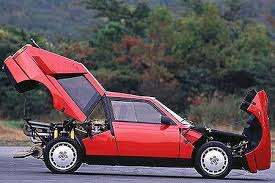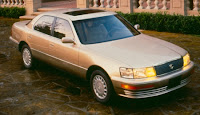You won't find the definition of a plain stoopid car in the dictionary, because there isn't one! Some of them are dangerous, some of them are eye-watering fast and some of them are just weird. But they're all interesting automotive ideas that make you wonder what had the companies' engineers been smoking when they designed these vehicles.
1973/1974 BMW 2002 Turbo:Taking the crown as Europe's first turbocharged road car, the 2002 Turbo is a wolf in sheep's clothing. It makes 170hp from this NON-intercooled, 2 litre 4 cylinder engine with a KKK turbo (the Klan must be really proud of this company) boostin' away. Said boost kicks in at 4,000 rpm and the engine runs out of puff at 5,800 rpm... on a car that weighed 1,080 kg. If the turbo wakes up in the middle of a turn, by the laws of physics, you're toast.
1985/1986 Lancia Delta S4 Stradale:
 Of all the Group B rally cars, the craziest one was the Delta S4. In rally spec, it ended up producing 600hp and a 0-100kph time of "less than two seconds"... in 1986. Lancia developped a twin-charged 1.8 4 cylinder monster that had the gas tank under driver and co-driver. Recipe for disaster? Yup. The company had to learn this the hard way during the 1986 Tour De Corse, where Henri Toivonen (driver) and Sergio Cresto (co-driver) got burned alive after plundging into a ravine. What really takes the cake is the fact that Lancia had to make 200 examples of the same car in road spec for homologation purposes.
Of all the Group B rally cars, the craziest one was the Delta S4. In rally spec, it ended up producing 600hp and a 0-100kph time of "less than two seconds"... in 1986. Lancia developped a twin-charged 1.8 4 cylinder monster that had the gas tank under driver and co-driver. Recipe for disaster? Yup. The company had to learn this the hard way during the 1986 Tour De Corse, where Henri Toivonen (driver) and Sergio Cresto (co-driver) got burned alive after plundging into a ravine. What really takes the cake is the fact that Lancia had to make 200 examples of the same car in road spec for homologation purposes.1986 Ford RS200 Evolution:
Designed from the ground up, the RS200 was Ford's SECOND answer (after the doomed Escort 1700T) to the Peugeot 205 T16 and the Audi S1. Out of the 200 cars that were built, 24 were equipped with the enlarged 2.1 litre BTD-E motor. At 8,000rpm, the car produced 580hp at 23psi, propelling it from 0-100kph in 3.07 seconds ... in 1986.
1969 Plymouth Superbird:
 The racing version of this car was mostly known for it's incredible (for the time) aerodynamics and it being capable of exceeding 320kph. As for the road version, it was admired for its enormous spoiler, its' engine and its' mascot: Roadrunner from the Looney Tunes! Believe it or not, Chrysler was cool enough to put massive stickers of Roadrunner on the massive rear wing and make the horn go "Beep-Beep", something that would've never happened today because 1. Plymouth doesn't exist anymore, 2. Today's car companies have no sense of "humor" and 3. Car companies' designers don't do LSD at work anymore.
The racing version of this car was mostly known for it's incredible (for the time) aerodynamics and it being capable of exceeding 320kph. As for the road version, it was admired for its enormous spoiler, its' engine and its' mascot: Roadrunner from the Looney Tunes! Believe it or not, Chrysler was cool enough to put massive stickers of Roadrunner on the massive rear wing and make the horn go "Beep-Beep", something that would've never happened today because 1. Plymouth doesn't exist anymore, 2. Today's car companies have no sense of "humor" and 3. Car companies' designers don't do LSD at work anymore.1962/1965 Peel P50:
 |
| If she only how much these minions are worth today... |
Built for 3 years by Peel, a company that started off in the 50's by building fiberglass motocycle fairings, it's the perfect example of British ingenuity. Apparently, a few "blokes" on The Isle of Man reckoned that the original Mini was a tad too large for their tastes, hence the creation of the P50. Weighing in at 59kg, it didn't have a reverse gear because you could simply get out, pick it up and turn it around. Genius. Unfortunately, only 100 original examples were ever made, and are fetching over 150k Euros, which is mental! Fortunately, a new company is offering exact replicas of the very same car, for a more reasonable 9,400 Euros MSRP. And I want one... badly.
1978-1979 Dodge Lil' Red Express:
 |
| Naked chick in the cab = Advertising done right. |
When this bad boy was tested by Car and Driver in 1978, it was the fastest american made vehicle from O-160kph. Sporting a modified 225hp 360c.i. V8, which could also be found in, you guessed it, the Dodge Diplomat and Plymouth Grand Fury police cars. However, the mechanical bits are only half the story, the other half being the exterior. "Lil' Red Express" stickers were splattered around the body, "teaming up" with two enormous stacks behind the cab and wood accents surrounding the truck's bed to give the truck a tasteful, funky look.
 |
| The Eazy-E of cars. |
Based on the Mk3 TVR Grantura, the Griffith 400 was a sports car thought up by Jack Griffith, owner of a Ford dealership in Long Island. This cute looking sports car was turned to a Shelby Cobra killer when Jack "dumped" a 289 c.i. Hi-Po, supplied by Ford, in the car. Armed with 271hp and a net weight of 635kg, this missile propelled itself from 0-100kph in 3.9 seconds, 6 tenths faster than the Cobra's "mildly entertaining" 4.5 second sprint... if said Cobra was equipped with the 427 V8, that is. Sadly, only 56 Griffith 400s were built and, shortly after, Griffith Motor Company faded away in the annals of automotive history.

1971-1980 Ford Pinto:
You know what I love about the Pinto? It's an excellent example of America's famed capitalist mindset. Once upon a time, when the "Japs" introduced to the Americans the idea of a subcompact car, a car that doesn't weigh a million tons and is capable of getting more than 3mpg, the "Big Three" thought designing their own. The Pinto was Ford's answer to cars like the Toyota Corolla, only that it took Ford only 2 years to design and engineer the car, instead of the normal 4 years. You wouldn't be wrong wrong to think that, somewhere, the car had a design fault. And boy did it have a good one. Just type "Ford Pinto Crash Test" on Youtube and enjoy. The fuel tank was placed right behind the bumper. So, in the very likely event of a rear end TAP, the car started to leak fuel. And if said tap a little more violent, the car would explode. Now, Ford had two choices: reinforce the rear of Pinto (121 million $) or the potential payout to victims (50 million $). Since there's no humanity in capitalism, Ford chose the second option... and probably threw an enormous party with Moët, prostitutes and acid to celebrate.
 1995-1998 Porsche 993 GT2:
1995-1998 Porsche 993 GT2:Apart from building extremely well built road cars, Porsche is also an expert in death traps. To be more precise, turbo death traps. The 993 GT2 was a homologation special for the GT2 racing series. What made it so deadly was a mix of its awful, Beetle-like weight distribution and a twin-turbo flat six, making between 430hp and 450 hp, depending on spec. Oh, and it weighed 1,295kg. More or less, it was 2 times deadlier than the original 930 Turbo. Or 12 times deadlier than a Beetle.
 1911 Fiat S76:
1911 Fiat S76: Isn't it amazing how much cars have advanced in more that 100 years? Today, the new Honda Civic Type R makes 306hp from a 2 litre four banger. Nevertheless, 115 years ago, "The Beast of Turin" made 300hp... out of a 28,4 litre 4 cylinder. It was a purpose built land speed record car, reaching 186kph in 1911 in Belgium, which must've felt like a zillion kph in a time where, in a drag race between a car and dog, the latter would probably decimate the car. Only two were ever built. Interestingly, the sole survivor is utilisining parts from both cars. Mint!




